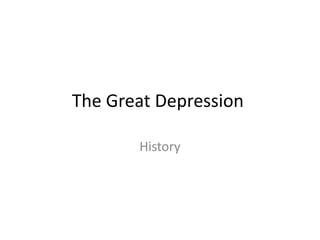
The Great Depression: Black Tuesday Triggers Decade of Poverty and Lost Opportunity
- 1. The Great Depression History
- 2. Background Began on “Black Tuesday” with the Stock Market Crash on October 1929 The market crash marked the beginning of a decade of high unemployment, poverty, low profits, deflation, plunging farm incomes, and lost opportunities for economic growth and personal advancement Led to a growing inequality between the wealthy and the poor The rich got richer and the poor got poorer The initial government response to the crisis exacerbated the situation; protectionist policies like the 1930 Smoot-Hawley Tariff Act stagnated world economy Industries that suffered the most included agriculture, mining, and logging as well as durable goods like construction and automobiles that people postponed Franklin D. Roosevelt's economic recovery plan, the New Deal instituted federal relief programs aimed at aiding the agricultural industries and support labor unions
- 3. Causes Money It is anything that society generally accepts as payment for goods and services Used as a medium of exchange Serves as a store of value or a form in which wealth can be held How is money created and controlled? Printed and coined by the federal government Excessive creation of money alternated with bank failures and the collapse of the monetary system National Monetary Commission to formulate a plan for a new American banking system Establishment of the Federal Reserve System in 1913
- 4. Causes Main Purpose of the Federal Reserve Prevent the failure of banks The Federal Reserve Act Bank notes were backed by gold, giving the money value Banks paid an interest rate to borrow funds from the Federal Reserve Banks. This interest rate was called the discount rate Federal Reserve Had an easy discount rate This allowed more money to circulate Widespread stock speculation Struggling Farmers Farmers mechanized and accumulated more debt to pay for the latest farming innovation Output increased and crop prices fell Dust Bowl in the Midwest prevented farmers from growing crops
- 5. Causes Weak Economy The prosperity of the 1920s was due to car and home sales. Industry produced more than Americans could buy. Lack of disposable income prevented people from buying consumer goods. Decreased sales caused industries to struggle Stock speculators began to sell of their stocks in fear of the losing value. Stock Speculation Many people speculated in the stock market. People bought on the margin Paid a down payment on the stock at a fraction of the price and used those stocks, which were not paid for, as collateral for more stock purchases Brokers began asking for full payments from people People began to sell uncontrollably when prices stopped rising Payments were lost and banks/businesses collapsed
- 6. Causes Decline of International Trade Because of World War I European businesses struggled. Europeans did not have money to buy consumer goods. The US demanded that foreign debts be paid either in dollars or in gold. Made it difficult for Britain and France to pay their loans to us especially when Germany defaulted on their payments to Great Britain and France. US protective tariffs caused European goods to cost more as a result. The Wall Street Crash of 1929 In June, factory output started declining. September 3, 1929 was the last day of rising prices. September 5, 1929, economic experts indicated a possible crash in the stock market. October 21, 1929, there was an immense amount of trading on the market. There was so much trading that the tick fell behind by 1 ½ hours Some people did not know they were ruined until after the stock market exchange closed. October 24, 1929, even more stocks were being sold on the stock exchange. Banks intervened by buying stocks in order to stabilize the market. This worked for a few days. (Morgan Bank, Chase National Bank, National City Bank) October 28, 1929, there were massive stock declines. October 29, 1929, people sold their stocks for whatever price they could get.
- 7. Consequences of theStock Market Crash Bank Failures Banks made unsound loans Depositor’s savings were wiped out as a result Many people stopped trusting banks with their savings In 1931: 1,300 banks failed Many people began saving their money instead of spending it because of job layoffs and bank failures Federal Reserve made the tight money supply worse by increasing the discount interest rate Discount interest rate: the rate the Federal Reserve charges banks on loans
- 8. Consequences of theStock Market Crash Short Term Large speculators lost all of their money These were the people that spent the most money so there was a downturn in spending Many people could not pay back the money they had borrowed to buy shares of stock Because of this, many insurance companies and banks went bankrupt Many Americans lost their entire life savings
- 9. Consequences of theStock Market Crash Long Term People kept their money instead of buying new consumer goods Businesses: Cut production further and laid off more workers Reduced the wages of those who still had jobs As workers were laid off or paid less, they bought even fewer goods By 1933, there were 14 million people unemployed and over 5,000 banks had failed Many farmers had lost their land so food began to cost more due to decreased production Many people lost their home and wandered around looking for work Increase in the amount of crime The general health of Americans decreased as malnutrition took its toll on suffering Americans
- 10. Life During the Depression Hoovervilles Shanty towns built by homeless people during the Great Depression Named after President Hoover Unemployment rampant Between 1929 and 1932 U.S. GDP fell around 30% and the stock market lost almost 90% of its value Between 1929 and 1932 the income of the average American family was reduced by 40% Unemployment rate in Cleveland, Ohio was 60% and in Toledo, Ohio it was 80% In comparison: Today’s unemployment rate in California is at 13.2%